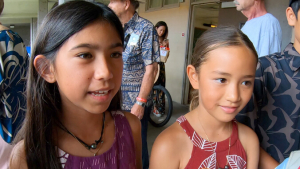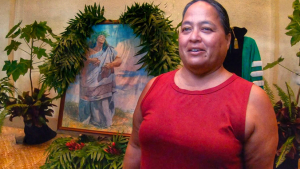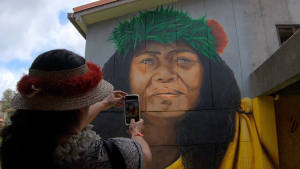“I think it’s good that they finally put a Native Hawaiian (woman) on a U.S. currency—that they recognize our culture,” exclaimed 10-year-old Opua Kern, holding her Edith Kanakaʻole quarter in a commemorative sleeve.

Kern joined about 1,000 who gathered to celebrate the iconic cultural practitioner’s legacy at the University of Hawaiʻi at Hilo on May 6, 2023. Kanakaʻole worked as a teacher at Hawaiʻi Community College and at UH Hilo in the 1970s, creating courses and seminars on subjects including Hawaiian language, ethnobotany, Polynesian history, genealogy and Hawaiian chant and mythology. The legendary educator passed away in 1979.
“How to sustain ourselves on the ʻāina (land), how to teach hula, how to oli (chant), how to speak Hawaiian—all of that was encapsulated in her and she positioned herself within the university system where she really needed to be,” said granddaughter Huihui Kanahele-Mossman, executive director of the Edith Kanakaʻole Foundation (EKF) and UH Hilo kuleana (responsibility) and curriculum development coordinator.

The U.S. Mint released the Edith Kanakaʻole quarter into circulation in March. The special coin was a collaboration between EKF, the U.S. Mint and the Smithsonian American Women’s History Museum. Kanakaʻole is one of five American women being recognized in 2023 as part of the National Women’s History Museum’s American Women Quarters™ Program.
“It means a lot to the U.S. Mint,” said U.S. Mint Deputy Director Kristie McNally. “It’s showing America the history of Hawaiʻi and what a wonderful impact she made to the history here and holding the culture.”
E hō mai ka ʻike
In one of many chicken skin moments that day, hundreds rose to their feet to chant “E hō mai ka ʻike” (granting the wisdom) at the opening ceremony. The first line of Kanakaʻole’s well-known oli is also inscribed on the quarter that honors her.
“Aunty Edith knew that for Hawaiʻi to thrive as a vibrant Indigenous space, she had to be willing to share the knowledge and wisdom of her ancestors,” said UH President David Lassner. “Her philosophy was to teach all who come, because one never knows who will advance the knowledge. This is important wisdom for the University of Hawaiʻi, which is widely recognized as one of the nation’s most diverse universities.”
Kanakaʻole founded Hālau o Kekuhi, an internationally recognized dance company. The Edith Kanakaʻole Multi-Purpose Stadium in Hilo where the Merrie Monarch Hula Festival is held is named in her honor. She was also a singer, composer and Nā Hōkū Hanohano award winner.
“The most important thing for people to take away from Aunty Edith’s legacy is the fact that throughout her lifetime she really advanced and tried to perpetuate—we would today call traditional ecological knowledge,” said Halena Kapuni-Reynolds, associate curator for Native Hawaiian history and culture for the National Museum for the American Indian. “So this is really a celebration of that knowledge base that she worked very hard to pass down to not only her children but to anyone who was willing to learn.”
The next generation

A mural of Kanakaʻole adorns the wall of UH Hilo’s Edith Kanakaʻole Hall where some of the festivities, including coin distribution were held. The mural is a collaboration between local artist Kamea Hadar, Kanakaʻole’s grandson Kūhaʻo Zane, creative director of Sig Zane Designs, with support from the UH Hilo Kīpuka Native Hawaiian Student Services. Attendees from keiki to kūpuna stopped to admire the artwork and found themselves enriched by the day’s activities.
“The amount that she has touched so many people is just astounding, not just through her hula, but through her teaching and through everyone that’s her legacy. I’ve never known anyone that had such a big legacy as Edith Kanakaʻole,” said Myles Walsh, a UH Hilo alumnus.
Kanakaʻole’s 14-year-old great grandaughter Malu Killion said, “I think everything she did is important to me and my family, because without her, I donʻt think Hawaiʻi would be in the position it is today.”
The Kanakaʻole’s family recently established the Hale Kanakaʻole Fund with the UH Foundation. The fund recognizes Kanakaʻole’s numerous contributions toward the promotion of Native Hawaiians’ educational pursuits, and provides support to students enrolled at any campus within the UH System with a preference for students of Native Hawaiian ancestry. Donations to the Hale Kanakaʻole Fund can be made via the UH Foundation.
Mossman said, “For the next generation, they realize this is who she was and this is the person that the hall is named after and this is the person that the multipurpose stadium is named after and now we know who she is and now we have another Native Hawaiian hero to follow after.”
—By Kelli Abe Trifonovitch

